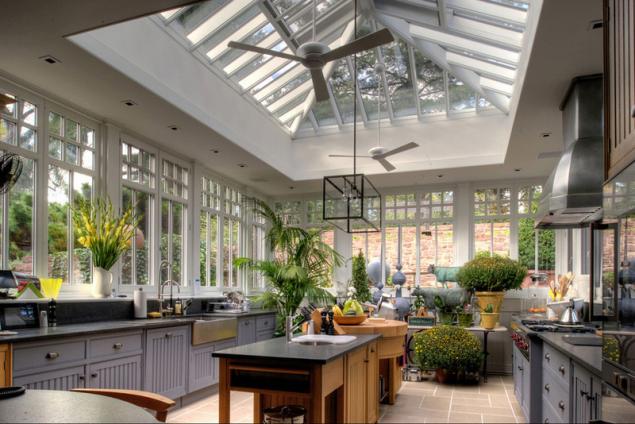903
The atmosphere in the room: what you need to know in order not to harm health
Human health is affected by factors in the environment in which it is located. The environment affects the human body through air, food, water factors and different radiation. These factors estimate the material effects, which may be harmless or even beneficial character, and can have a negative effect on human health.
Most of the people most of the time spends in confined spaces – residential or public use. An important factor of influence on the human body in the areas microclimate.

The definition of climate and its components Climate characteristic of Land has some connection with the prevalence of certain diseases. Certain diseases (attributable to colds), there is marked seasonality associated with persistent changes in weather conditions. Some areas with a favorable climate, due to this factor referred to natural climatic resort areas – they are its natural weather effects have a beneficial effect on human health.
Climate characteristics in an isolated space, for various purposes, are called the microclimate. The factors of the air environment in premises define its characteristics, and they are able to influence people's health.
Key features of the microclimate:
The combination of these factors (various units) determines the microclimate which can be characterized as:
The climate factors negatively affecting health are: the velocity of air above the normal limits ("draught"), exceeding the permissible level of humidity. Moisture reduction (below the standard) and the lack of mobility of the air also adversely affect human health.
To determine the appropriate and acceptable properties of the microclimate developed a special hygienic performance. They are fixed in the regulatory documents that are binding on the entire territory of Russia.
Regulated indicators and the standardsof Hygienic norms of microclimate indicators for residential buildings are regulated by sanitary rules and norms. In 2010, enacted the "Sanitary-epidemiological requirements to living conditions in residential buildings and premises" (2.1.2.2645-10).
This regulatory document establishes requirements to the indicators of the microclimate in the premises: temperature, humidity and speed of air movement. The differences in the temperature settings due to the season of the year and the function of specific areas. There is a separate hygienic standards for schools, kindergartens, medical and social institutions.
The main standardized indicators and standards for premises the premises Temperature air (limit values, °C) Humidity (relative) ( % ) Mobility (speed, m/s) Living room (cold season) 18-24 60 0,2 Living room (warm season) 20-28 65 0,3 kitchen 18-26 Not regulated 0,2 Interroom corridors 16-22 60 0,2 Bathroom, a bathroom (combined) 18-26 Not regulated 0,2 toilet 18-26 Not regulated 0,2 For public buildings, the norms of microclimate parameters approved by the interstate standard GOST 30494-2011 "residential and public Buildings. The parameters of the microclimate in the premises". Temperature regimes vary in the premises of various functional purpose (category). In addition to the permissible temperature and humidity values of the air environment, the document lists the optimum values.
The incidence of and measures on formation of a healthy microclimate Unfavorable climate, with prolonged action, having a cumulative negative effect on human health, comparable to continuing stress. Suffer the body's defenses, reduced immunity increases the risk of morbidity for viral and bacterial infections, inflammatory diseases. Poor sleep, lack of energy, irritability is often the result of poor microclimatic conditions.

Ensuring the standards of microclimatic indicators should be provided before the start of construction. When designing residential or public buildings mandatory calculation of the efficiency of heating and ventilation. The task of designers is to provide effective heat mode, the ability of ventilation systems and air conditioning systems to ensure the favorable performance of the microclimate in different seasons.
Depending on the local climatic conditions must meet different requirements of thermal conductivity of building structures, the thickness of the glass, the capacity of the heating equipment and air conditioning systems, the ventilation rate, the cross section of the ducts, etc. All these indicators will allow to provide reliable and comfortable microclimatic conditions in winter cold and summer heat.
In areas with deviations from the permissible parameters of the microclimate necessary to carry out works of reconstruction, improvement or increase of efficiency in the following systems technical support, responsible for the formation of climate:
P. S. And remember, only by changing their consumption — together we change the world! ©
Source: my-health.ru/content/295-mikroklimat-pomeshcheniy-i-zdorove
Most of the people most of the time spends in confined spaces – residential or public use. An important factor of influence on the human body in the areas microclimate.

The definition of climate and its components Climate characteristic of Land has some connection with the prevalence of certain diseases. Certain diseases (attributable to colds), there is marked seasonality associated with persistent changes in weather conditions. Some areas with a favorable climate, due to this factor referred to natural climatic resort areas – they are its natural weather effects have a beneficial effect on human health.
Climate characteristics in an isolated space, for various purposes, are called the microclimate. The factors of the air environment in premises define its characteristics, and they are able to influence people's health.
Key features of the microclimate:
- humidity indoors;
- temperature mode;
- the movement of air (velocity).
The combination of these factors (various units) determines the microclimate which can be characterized as:
- optimal;
- valid;
- unfavorable.
The climate factors negatively affecting health are: the velocity of air above the normal limits ("draught"), exceeding the permissible level of humidity. Moisture reduction (below the standard) and the lack of mobility of the air also adversely affect human health.
To determine the appropriate and acceptable properties of the microclimate developed a special hygienic performance. They are fixed in the regulatory documents that are binding on the entire territory of Russia.
Regulated indicators and the standardsof Hygienic norms of microclimate indicators for residential buildings are regulated by sanitary rules and norms. In 2010, enacted the "Sanitary-epidemiological requirements to living conditions in residential buildings and premises" (2.1.2.2645-10).
This regulatory document establishes requirements to the indicators of the microclimate in the premises: temperature, humidity and speed of air movement. The differences in the temperature settings due to the season of the year and the function of specific areas. There is a separate hygienic standards for schools, kindergartens, medical and social institutions.
The main standardized indicators and standards for premises the premises Temperature air (limit values, °C) Humidity (relative) ( % ) Mobility (speed, m/s) Living room (cold season) 18-24 60 0,2 Living room (warm season) 20-28 65 0,3 kitchen 18-26 Not regulated 0,2 Interroom corridors 16-22 60 0,2 Bathroom, a bathroom (combined) 18-26 Not regulated 0,2 toilet 18-26 Not regulated 0,2 For public buildings, the norms of microclimate parameters approved by the interstate standard GOST 30494-2011 "residential and public Buildings. The parameters of the microclimate in the premises". Temperature regimes vary in the premises of various functional purpose (category). In addition to the permissible temperature and humidity values of the air environment, the document lists the optimum values.
The incidence of and measures on formation of a healthy microclimate Unfavorable climate, with prolonged action, having a cumulative negative effect on human health, comparable to continuing stress. Suffer the body's defenses, reduced immunity increases the risk of morbidity for viral and bacterial infections, inflammatory diseases. Poor sleep, lack of energy, irritability is often the result of poor microclimatic conditions.

Ensuring the standards of microclimatic indicators should be provided before the start of construction. When designing residential or public buildings mandatory calculation of the efficiency of heating and ventilation. The task of designers is to provide effective heat mode, the ability of ventilation systems and air conditioning systems to ensure the favorable performance of the microclimate in different seasons.
Depending on the local climatic conditions must meet different requirements of thermal conductivity of building structures, the thickness of the glass, the capacity of the heating equipment and air conditioning systems, the ventilation rate, the cross section of the ducts, etc. All these indicators will allow to provide reliable and comfortable microclimatic conditions in winter cold and summer heat.
In areas with deviations from the permissible parameters of the microclimate necessary to carry out works of reconstruction, improvement or increase of efficiency in the following systems technical support, responsible for the formation of climate:
- heating system (system cleaning, installation of radiators with efficient heat transfer equipment systems for thermoregulation, etc.);
- ventilation;
- air-conditioning.
P. S. And remember, only by changing their consumption — together we change the world! ©
Source: my-health.ru/content/295-mikroklimat-pomeshcheniy-i-zdorove
The instigators of Alzheimer's disease in your plate
Indecision is a decision to leave things as they are























